After the Fire
The Conservation and Repair of Royston Parish Church
Kate Gunner
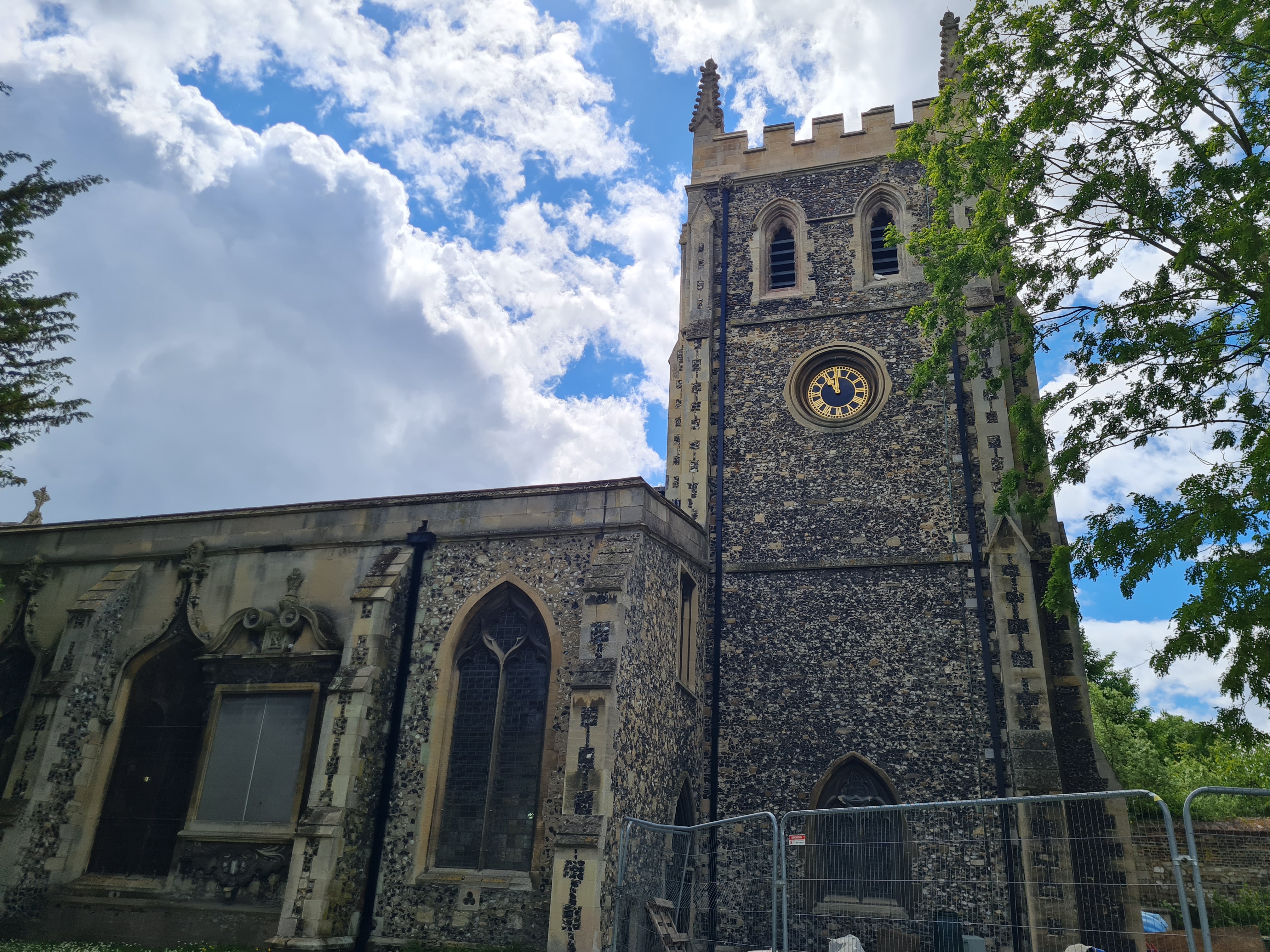
The tower where the fire started (All photos: Kate Gunner)
For those of us who work in conservation there are few sights more dreadful than when a church is damaged or destroyed by fire. Fire does not respect the irreplaceable architecture or its history, nor the memories of the community and their ancestors who may have worshiped there for generations.
Sadly, the destruction invariably extends to include areas which were not directly damaged by the flame or heat of the fire, but indirectly, by the smoke, soot and falling debris, or by the large volume of water used to extinguish the fire.
This was the case for St John the Baptist, a Grade I listed church in Royston, Hertfordshire, when it suffered a fire in the early hours of 9th December 2018. It took six fire engines with around 25 fire crew to extinguish it.
| Charred surface of a boss from the ceiling of the nave |
The fire devastated the tower where it started, including the bell ringing chamber and all interior woodwork. Significant damage was also caused to the west end of the nave and aisles, which were built around 1250 and originally formed the quire and sanctuary of a large church belonging to the Augustinian Priory of Royston. The church suffered from subsequent damage including the partial collapse of the nave roof, and the failure of several areas of the floor where there were underlying voids as a result of the water used to extinguish the fire. The interior and contents of the whole church suffered extensive smoke damage.
The cause of the fire has not been fully identified. It was originally feared that lead had been stolen from the roof, but after an investigation the police concluded that these claims were unfounded and ruled out arson as the cause.
Most of the repair and conservation work has been covered by the insurance, and additional funds were raised for further improvements by the parochial church council with the help of the community.
Within weeks of the fire a designed Layher system scaffold was urgently erected with a temporary roof to protect the church from the winter weather. In May 2019, under instruction from property consultants Barker Associates, a specialist heritage construction company, Bakers of Danbury Ltd, began the enabling works which involved stripping all fire damaged material, moving the church assets into storage and making the structure safe. Further scaffolding was erected inside the tower to enable the client’s building consultants to survey the damage and prepare detailed specifications for the reinstatement works. The final stage of works started in April 2021 and are due to be completed late summer 2022.
Above and below: Installing new stainless steel flitch plates and brackets to extend the principal rafters across to the new outer wall plate
Cleaning Fire Damaged Stone and Wood
Cleaning trials using dry ice blasting and DOFF were carried out in inconspicuous places throughout the interior and exterior of the church, on both soiled stone and fire damaged timber. These enabled Bakers of Danbury’s team to determine the ideal pressure to clean the fire damaged timbers and stone sympathetically, with least risk to the substrate.
The DOFF method of cleaning uses a high temperature steam and is designed to remove dirt and grime without the use of chemicals and without abrading the surface. While the temperature of the steam is high, the volume of water used is low and the surface will be dry within minutes.
The dry ice blasting method of cleaning uses a solid form of carbon dioxide commonly known as dry ice. Particles of the compound are sent through an air stream at a fast speed, and when they make contact with the surface they expand instantly from a solid to a gas. The expansion causes momentary freezing at the surface and the thermal shock helps to remove the dirt and grime. The combined effect reduces the amount of abrasion to the surface and no water is introduced, so the only residue is the dirt. This was the principal cleaning method used on the masonry and the only one used on the timbers.
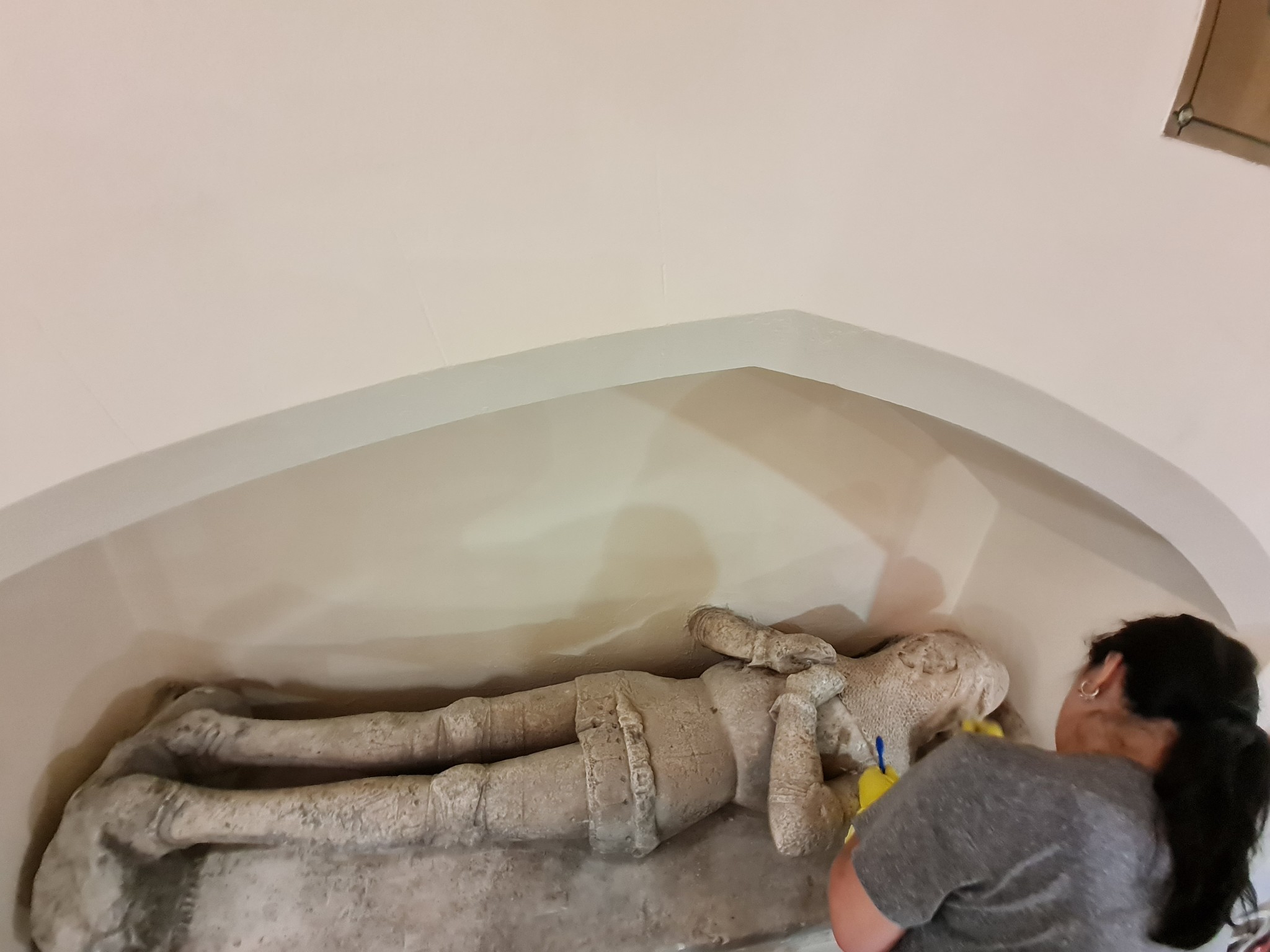
Specialist cleaning of a stone effigy
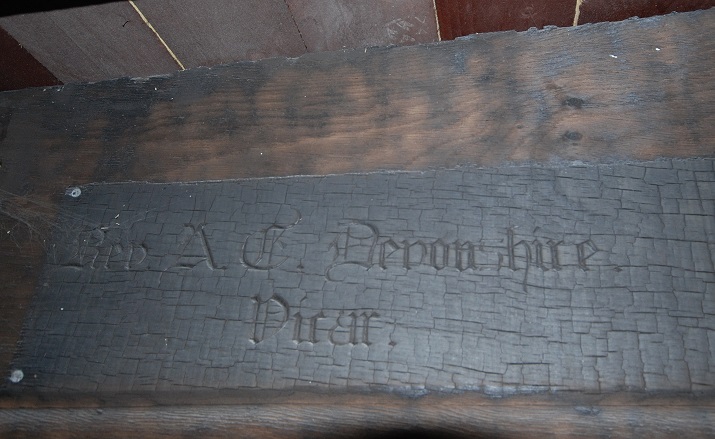
One of the carved inscriptions that would have been lost if the whole timber had been cleaned
Conservation of Timberwork and Roofs
In preparation for redecoration, dry ice blasting was used to clean all burnt timbers in the nave roof which had suffered significant fire damage. As well as removing the softer charred timber without damaging the sound timber beneath, this method of cleaning was also ideal for removing the odour left after the fire.
| Not all the roof timbers could be salvaged. |
Bakers of Danbury’s team then repaired the original inner wall plate and introduced a new secondary outer wall plate to give additional support to the rafters across the width of the wall. The principal rafters are over 200 years old, each measuring approximately 400 x 400mm and 10m long, and were from very large oak trees. The surviving stones of the arch were then cleaned using the DOFF method to ensure the new replacement Ancaster stone blended in. It was important to restore and retain these principal rafters as they are very rare, and it would be difficult to source a replacement. The team restored all seven principal rafters which form the main structural frame within the nave roof. Some of the principal rafters were badly damaged, particularly near the tower where the fire had been concentrated, some required additional support to engage the beam ends onto the new timber wall plates which was achieved by using large stainless steel flitch plates and brackets weighing in excess of 175 kg each. The common rafters were repaired and cleaned, or replaced where beyond repair.
On the tower a new suspended timber roof was installed with steel supporting girders spanning seven metres. This was covered in sand cast lead (code 7) and the rainwater goods were replaced with cast aluminium.
Carved Inscriptions and Roof Bosses
When all timbers were being ice blasted to remove fire and smoke damage, it was realised that it would be impossible to remove the charring without losing some of the carved inscriptions, historical graffiti and fine detail of the roof bosses. The inscriptions on the roof timbers record former church wardens, reverends and people within the community as far back as 1601, and although damaged by the fire, they are still legible. Bakers of Danbury employed conservators Hirst Conservation to carry out a survey, analyse samples and provide a review of treatment options. The conservators recommended that the historic graffiti should be stabilised and their appearance retained. For the carved inscriptions and roof bosses Hirst Conservation adopted a tailored treatment for each, as they were fire damaged to varying degrees. All were successfully conserved and will tell the history of the church for many generations to come.
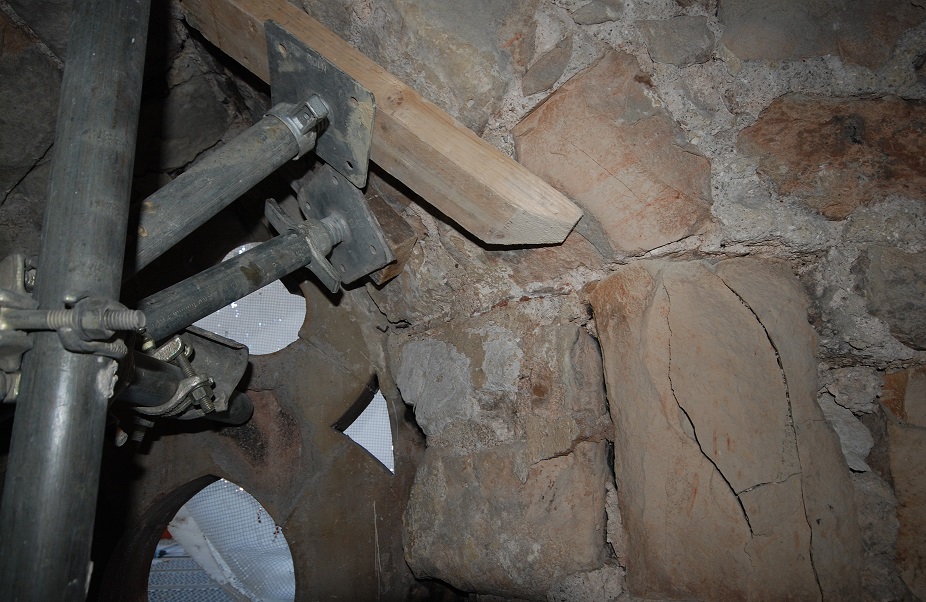
Cracked and spalling masonry in the tower caused by the cooling effects of water from the fire hoses when fighting the fire
Stonework Conservation
The fire was concentrated in the tower but it also travelled to the nave via the arch which connects the two. Due to its location, the stone arch sustained an extreme amount of heat from the fire which significantly affected its structural integrity, and large sections were now fractured, brittle and spalling away. As a result, it was necessary to replace the complete intrados and extrados (tower side only) of the moulded arch, spanning a massive five meters. Ancaster Hard White was found to provide a suitable match for the existing stone.
Following a detailed survey, Bakers of Danbury’s sister company, Collins and Curtis Masonry Ltd produced the individual arch voussoirs in their masons’ workshops in Ipswich, using measurements from the original fire damaged arch. To help install them correctly, a full-size timber former was constructed within the arch, and then removed when the last voussoir was slotted into place. The surviving stones of the arch were then cleaned using the DOFF method to ensure the new replacement Ancaster stone blended in.
| A new quatrefoil window surround carved from Ancaster Hard White stone |
After a number of cleaning trials, the DOFF method was also used to gently clean the stone columns within the nave, the belfry openings to the tower and all external stone and flint walls on the tower. DOFF was chosen because it enables control of the water pressure and temperature used, which helps prevent overcleaning the surface. This was particularly important when cleaning the external stone and flint on the tower as the team did not want to remove the underlying patina (the natural variations in colour and texture which develop over many years of weathering).
Dry ice blast cleaning techniques were carried out in other isolated areas of the church which suffered fire and smoke damage, for example around the stone windows, doors and arches.
Bakers of Danbury’s team carried out extensive repairs to the internal walls of the tower, particularly at the belfry level where it had been damaged by the intense heat and by the large volumes of water used to extinguish the fire. Tottenhoe was sourced to match the original clunch (a chalky form of limestone) and used to replace the inner jambs to all ten of the lancet-arched openings to the tower. This required around 300 new shaped jamb stones and all new Welsh slate louvres. Repairs to the interior of the tower required over 500 new ashlar stones and the walls had to be completely re-pointed using lime mortar. Large structural fractures found when the plaster was fully removed were stitched with large pieces of stone, and the walls finally covered with limewash.
A stone quatrefoil window was replaced using Ancaster Hard White stone and new merlon copings (the uppermost copings on a crenellated parapet) produced from Barnack Stone were installed to the tower parapets. Lower sections to the moulded stone columns to the nave arcade, also affected by the fire and water damage, were carefully replicated and replaced using Chicksgrove stone as the best match for the original.
Conservation of Fragments Medieval Wall Paintings
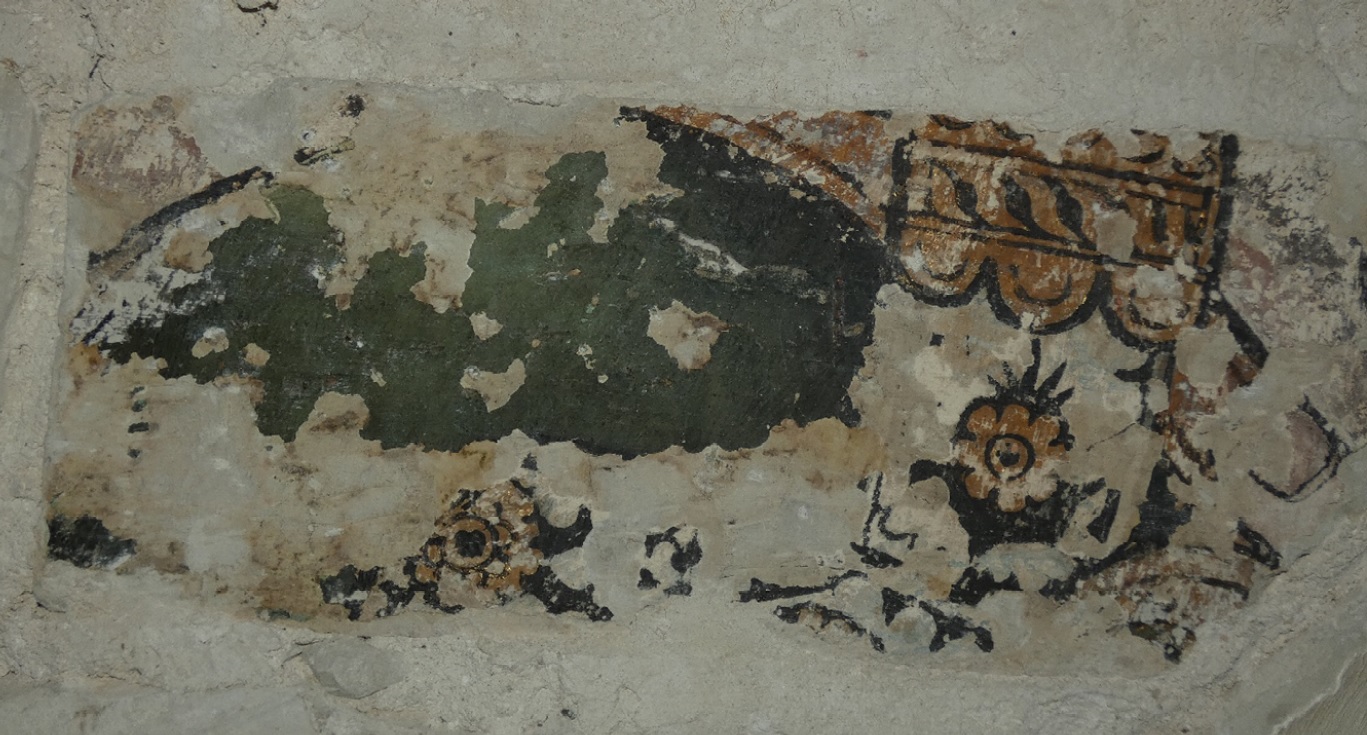
Painted decoration from the late 15th or early 16th century which was uncovered during the work
All fire- and water-damaged plaster was removed, and the walls were re-plastered with a breathable three-coat lime plaster (coarse hair coat, scratch coat and fine finish coat). Further from the seat of the fire the walls did not look too bad, but the surfaces retained an oily residue from the smoke which a traditional limewash would not have adhered to. Both old and new plastered surfaces were therefore finished with Zinsser Grade 1, a highly breathable modern paint system which was found to adhere well to surfaces contaminated by smoke deposits [1]. This was tinted to a suitable colour.
As the damaged plaster was being removed from the south wall of the north aisle, fragments of historic painted decoration were revealed in the spaces between arches. At the request of the property consultants, wall paintings specialists Tobit Curteis Associates were brought in to undertake an initial inspection of the painted decoration and to make recommendations for its protection and conservation. The painting was limited to specific blocks of clunch and in all cases the scheme was found to have been painted directly onto the blocks – indicating that the decorated limestone blocks had been reused from an area once covered by a large-scale scheme of decoration. The painting is obscured by post medieval limewash residues remaining on the surface.
The paintings consist of a foliate background and elaborate gilded floral decoration. The white ground may be white lead covered with multiple layers of dense pigment in an organic medium, possibly oil, and are likely to include red and yellow ochre, lime white, lead white, red lead, vermillion, synthetic copper greens, including verdigris and copper resinate, carbon black and gold leaf.
Tobit Curteis Associates stated that style of the painting indicates it is of the late 15th or early 16th century, and the detail and materials indicate that it is finely painted and of significance. Of the details that are visible, there is clearly a background of foliage, including grass and a section of a painted timber with a knot. The ornate decorative details may be elaborate architectural decoration or details of fine cloth and clothing. The subject of the painting is unclear, but the details are all ones which are commonly found in Crucifixion and Doom paintings of the period. As part of the conservation of the painted decoration, they were recorded and covered over again.
[1] According to the manufacturer, Zinsser Grade 1 is based on a speciality resin which allows very high pigmentation of the paint while still ‘binding’ it together. The pigment volume of the dry film is in excess of 70%. This makes it extremely breathable as there are micro voids and pathways for water vapour to pass through, but not large enough for liquid water to pass. The pigments are calcium carbonate, talc and titanium dioxide, all micronised.
Recasting the Bells
During the fire, the intense heat (measured as high as 600°C by the fire brigade) followed by the cold water used to extinguish the fire, resulted in cracks forming in all eight bells which dated back to 1739. John Taylor and Co Bell Foundry recast all eight bells from the usable portion of the original metal, and rehung them in 2021. Bakers of Danbury’s team carried out structural repairs to the ends of the large steel beam and thoroughly cleaned and redecorated the existing metal bell frame.
Final Redecoration and Refurbishment Throughout the Church
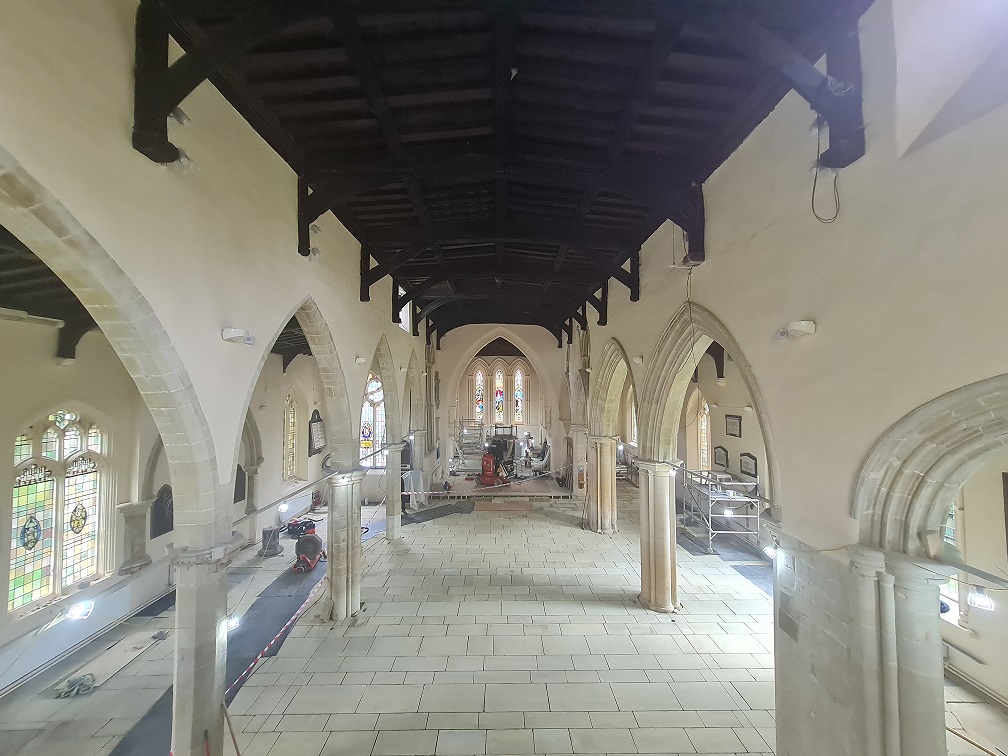
The new stone floor with a wet underfloor heating system
All existing leaded and stained glass windows were carefully cleaned and restored. The broken clerestory windows were replaced with a traditional handmade ‘mouth blown’ antique glass (which gives the glass its inconsistent, crinkled texture effect) to match the existing glass.
In many areas where the interior walls of the church had been affected by the fire and saturated by the fire brigade’s water, layers of paint were now peeling, resulting in a dusty surface. The layers included a multitude of different paints used over the years. Zinsser Peel Stop was applied to these areas to bind the existing paint and form a sound surface for the new paint. This is a clear acrylic binder that stays flexible and helps prevent peeling by letting moisture escape.
The whole church has been fully redecorated, the fire damaged kitchen and toilet were completely refurbished, a new sophisticated LED lighting system, audio-visual system and fire prevention alarm system installed.
A wet underfloor heating system was laid within a new breathable floor, measuring in excess of 300 sq m. The new breathable floor, Ty Mawr’s Sublime, is an insulated limecrete flooring system made up of two layers. The first layer is made entirely from recycled glass – acting as hardcore and construction layer, while also providing moisture management and insulation. The second layer is a breathable limecrete slab, made from a blend of natural hydraulic lime and recycled aggregates – a perfect alternative to concrete for use in traditionally constructed solid wall buildings.
The floor was finished with 50mm thick sandstone paving with a riven finish, except in the nave and aisles where the existing very large and heavy ledger stones were reincorporated into the new floor construction after they had been cleaned and repaired by conservators.
The ornately carved wooden pulpit in the nave was gently steam cleaned and repolished. However, the fire had devastated all other joinery within the church, so Bakers of Danbury’s joinery workshop has manufactured new solid oak furniture which includes large vestment cupboards and a bespoke servery designed to sit seamlessly within the nave.



